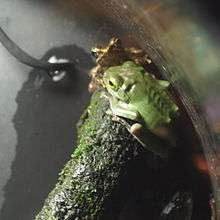Rhacophorus viridis
| Rhacophorus viridis | |
|---|---|
 | |
| Scientific classification | |
| Kingdom: | Animalia |
| Phylum: | Chordata |
| Class: | Amphibia |
| Order: | Anura |
| Family: | Rhacophoridae |
| Subfamily: | Rhacophorinae |
| Genus: | Rhacophorus |
| Species: | R. viridis |
| Binomial name | |
| Rhacophorus viridis (Hallowell, 1861) | |
| Synonyms | |
|
Polypedates viridis Hallowell, 1861 | |
Rhacophorus viridis (Okinawan tree frog) is a species of frog in the Rhacophoridae family. It is endemic to Ryukyu Islands, Japan. It is known from Amamioshima, Kakeromajima, Ukejima, Yoronjima and Tokunoshima islands of the Amami Group, and Okinawajima, Iheyajima and Kumejima islands of the Okinawa Group.[2]
Two subspecies are distinguished: Okinawa green tree frog (Rhacophorus viridis viridis) of the Okinawa Group and Amami green tree frog (Rhacophorus viridis amamiensis) of the Amami Group.[1][2]
Rhacophorus viridis is no longer present on Yoronjima island. Its disappearance from the island some time after 1958 is attributed to habitat change (conversion of paddy fields to drier habitats) and an introduced predator, Japanese weasel (Mustela itatsi). This is the first island-level extinction of a native amphibian in the Ryukyu Archipelago during modern times.[3]
Rhacophorus viridis is a moderate-sized rhacophorid frog (snout-vent length 65–84 mm (2.6–3.3 in)).[3] It is a common species in forests close to paddy fields and wetlands. It breeds in wetlands and paddy fields by larval development.[1]
References
- 1 2 3 Kaneko, Y. & Matsui, M. (2004). "Rhacophorus viridis". IUCN Red List of Threatened Species. Version 2013.1. International Union for Conservation of Nature. Retrieved 1 November 2013.
- 1 2 Frost, Darrel R. (2013). "Rhacophorus viridis (Hallowell, 1861)". Amphibian Species of the World 5.6, an Online Reference. American Museum of Natural History. Retrieved 1 November 2013.
- 1 2 Nakamura, Y.; Takahashi, A.; Ota, H. (2009). "Evidence for the recent disappearance of the Okinawan tree frog Rhacophorus viridis on Yoronjima Island of the Ryukyu Archipelago, Japan". Current Herpetology. 28: 29–33. doi:10.3105/018.028.0105.
